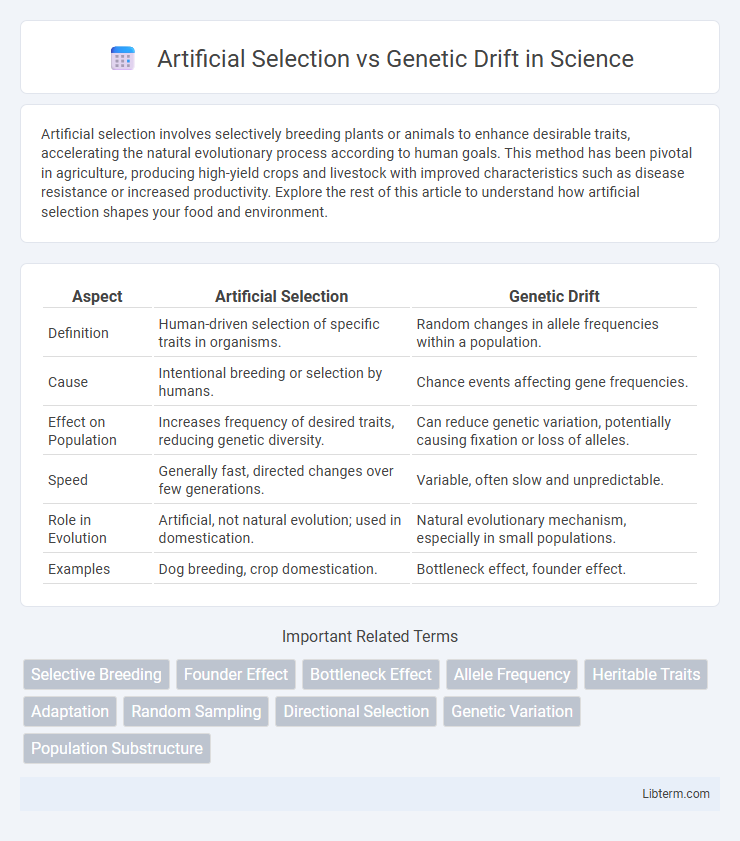Artificial selection involves selectively breeding plants or animals to enhance desirable traits, accelerating the natural evolutionary process according to human goals. This method has been pivotal in agriculture, producing high-yield crops and livestock with improved characteristics such as disease resistance or increased productivity. Explore the rest of this article to understand how artificial selection shapes your food and environment.
Table of Comparison
| Aspect | Artificial Selection | Genetic Drift |
|---|---|---|
| Definition | Human-driven selection of specific traits in organisms. | Random changes in allele frequencies within a population. |
| Cause | Intentional breeding or selection by humans. | Chance events affecting gene frequencies. |
| Effect on Population | Increases frequency of desired traits, reducing genetic diversity. | Can reduce genetic variation, potentially causing fixation or loss of alleles. |
| Speed | Generally fast, directed changes over few generations. | Variable, often slow and unpredictable. |
| Role in Evolution | Artificial, not natural evolution; used in domestication. | Natural evolutionary mechanism, especially in small populations. |
| Examples | Dog breeding, crop domestication. | Bottleneck effect, founder effect. |
Introduction to Artificial Selection and Genetic Drift
Artificial selection is a process where humans intentionally breed organisms with desirable traits to enhance specific genetic characteristics within a population, often seen in agriculture and animal husbandry. Genetic drift refers to random changes in allele frequencies in a population due to chance events, significantly impacting small populations and leading to genetic variation loss. Both mechanisms influence evolutionary outcomes but differ fundamentally in intentionality and scale of effect.
Defining Artificial Selection
Artificial selection is the intentional breeding of organisms to enhance or propagate desirable traits, directly influencing allele frequencies within a population. Unlike genetic drift, which involves random changes in allele frequencies due to chance events, artificial selection is a purposeful process driven by human choice. This targeted manipulation accelerates evolutionary changes by favoring specific phenotypes linked to beneficial genetic variations.
Understanding Genetic Drift
Genetic drift refers to random fluctuations in allele frequencies within a population, especially pronounced in small populations, leading to changes in genetic diversity independent of natural selection. Unlike artificial selection, which intentionally drives allele frequency changes through human intervention, genetic drift occurs naturally and can result in the loss or fixation of alleles over generations. This process significantly impacts evolutionary dynamics by introducing randomness to gene pools, influencing traits without adaptive advantage or disadvantage.
Key Differences Between Artificial Selection and Genetic Drift
Artificial selection involves intentional breeding to promote specific traits, driven by human preferences and goals, whereas genetic drift is a random change in allele frequencies due to chance events in small populations. Artificial selection results in predictable and directed genetic changes, often accelerating trait evolution, while genetic drift causes unpredictable variations that may lead to loss of genetic diversity. The scale and purpose distinguish them fundamentally: artificial selection is goal-oriented and controlled, genetic drift is stochastic and uncontrolled.
Mechanisms of Artificial Selection
Artificial selection operates through intentional breeding choices to enhance desirable traits in organisms, contrasting with the random allele frequency changes caused by genetic drift. This mechanism involves selective mating, controlled propagation, and human-imposed selection pressures, targeting traits like yield, appearance, or behavior in plants and animals. By consistently choosing specific phenotypes, artificial selection accelerates evolutionary changes, producing predictable genetic outcomes across generations.
Mechanisms of Genetic Drift
Genetic drift operates through random fluctuations in allele frequencies within small populations, driven primarily by chance events rather than selective pressures. Mechanisms of genetic drift include the bottleneck effect, where a population undergoes a drastic reduction in size leading to loss of genetic variation, and the founder effect, where a new population is established by a small number of individuals carrying only a fraction of the original population's genetic diversity. These random processes result in changes that can significantly impact population genetics independent of an organism's fitness or adaptive value.
Examples of Artificial Selection in Agriculture and Animals
Artificial selection in agriculture includes the selective breeding of crops like wheat and corn for higher yield, disease resistance, and drought tolerance, directly influencing genetic traits to meet human needs. In animal husbandry, artificial selection is exemplified by the breeding of cattle for increased milk production and dogs for specific behavioral traits, such as herding or companionship. These intentional breeding practices contrast with genetic drift, which causes random fluctuations in allele frequencies without human intervention.
Case Studies of Genetic Drift in Natural Populations
Genetic drift significantly influences allele frequencies in small populations, as demonstrated by the classic case of the Florida panther, where population bottlenecks led to reduced genetic diversity and increased inbreeding. Another example includes the isolated population of Darwin's finches on the Galapagos Islands, where random fluctuations in allele frequencies have driven phenotypic variations independent of natural selection. These case studies underscore how genetic drift operates as a stochastic evolutionary force distinct from artificial selection, shaping genetic structure through chance events rather than directed breeding.
Evolutionary Impacts: Artificial Selection vs Genetic Drift
Artificial selection drives evolutionary changes by intentionally favoring specific traits, resulting in rapid allele frequency shifts and targeted adaptation within populations. Genetic drift causes random fluctuations in allele frequencies, especially in small populations, leading to unpredictable evolutionary trajectories and potential loss of genetic diversity. The evolutionary impact of artificial selection is directional and purposeful, whereas genetic drift introduces stochastic variation without adaptive intent.
Conclusion: Implications for Biodiversity and Evolution
Artificial selection directs genetic variation according to human preferences, often reducing genetic diversity and potentially limiting adaptive potential in populations. Genetic drift causes random fluctuations in allele frequencies, which can lead to loss of genetic variation especially in small populations, influencing evolutionary trajectories unpredictably. Understanding the distinct impacts of artificial selection and genetic drift is crucial for biodiversity conservation and managing evolutionary processes in natural and engineered populations.
Artificial Selection Infographic

 libterm.com
libterm.com